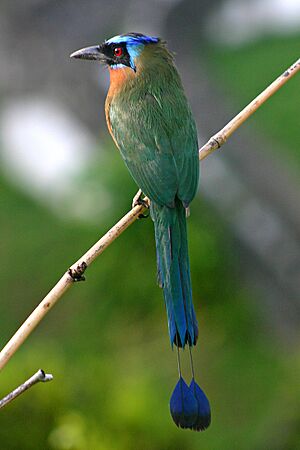Motmot facts for kids
Quick facts for kids Motmots |
|
|---|---|
 |
|
| Trinidad motmot Momotus bahamensis |
|
| Scientific classification |
|
| Kingdom: | Animalia |
| Phylum: | Chordata |
| Class: | Aves |
| Order: | Coraciiformes |
| Family: | Momotidae GR Gray, 1840 |
| Genera | |
Motmots are a group of colorful birds belonging to the family Momotidae. They are part of a larger bird group called Coraciiformes, which also includes birds like kingfishers, bee-eaters, and rollers. All motmots alive today live in woodlands or forests in Central America and South America. The biggest motmots are found in Central America.
These birds have bright feathers and a strong beak. Most motmots have long tails, and some even have a special "racket-like" tip on their tail feathers. The only exception is the tody motmot, which has a shorter, plain tail.
Contents
What Do Motmots Eat?
Motmots are omnivores, meaning they eat both plants and animals. They enjoy small prey like insects and lizards. They also like to eat fruit. Interestingly, in Nicaragua and Costa Rica, some motmots have been seen eating poison dart frogs.
Where Do Motmots Live?
Motmots are found only in the Americas, from Mexico down to Argentina. The largest number of different motmot types live in Honduras and Guatemala. There are seven different kinds of motmots found in these two countries. The motmot is also a very special bird, as it is the national bird of both Nicaragua and El Salvador.
How Do Motmots Build Their Nests?
Like many birds in their group, motmots build their nests in tunnels. They dig these tunnels into banks of earth. Female motmots usually lay about four white eggs.
Motmot Life Cycle
After about 20 days, the eggs hatch, and tiny motmot chicks emerge. The young birds stay in the nest for another 30 days. During this time, both the mother and father motmot work together to care for their babies. They bring food and protect them until they are ready to leave the nest and fly on their own.
Why Do Motmots Wag Their Tails?
Motmots are known for a unique behavior called the "wag-display." They move their tails back and forth, which often helps people spot them even when they are hidden. Scientists have studied this behavior, especially in the turquoise-browed motmot. They found that motmots do this wag-display when they see predators nearby.
This tail wagging seems to be a way for the motmot to tell the predator, "I see you, and I'm ready to escape!" This signal is helpful for both the motmot and the predator. The motmot avoids wasting energy by running away unnecessarily. The predator also avoids a difficult chase that might not end in catching the bird.
The Mystery of the Racket Tail
Many species of motmots have a unique "racket" shape at the end of their two longest tail feathers. For a long time, people thought that motmots actually plucked their own feathers to create this shape. This idea came from some incorrect reports.
However, we now know that this isn't true. The feathers near the ends of these two tail feathers are naturally weak. They break off or fall off during normal preening (when birds clean their feathers) or when they rub against things. This leaves a bare shaft with a tuft of feathers at the very tip, creating the racket shape.
Not all motmots have this racket tail. Some species, like the tody motmot, blue-throated motmot, rufous-capped motmot, and some populations of the rufous and broad-billed motmots, have normal, plain tails.
How Motmots Are Related to Other Birds
Scientists study how different animals are related to each other. They use a kind of family tree called a cladogram to show these relationships. Motmots are part of the Coraciiformes order, which includes several other bird families.
Here's how the different families in the Coraciiformes order are related:
| Coraciiformes |
|
||||||||||||||||||||||||||||||
Scientists have also found some very old fossils that might be related to motmots. One fossil bird, called Protornis, was found in Switzerland and lived about 30 million years ago. It might be an early type of motmot or a very old relative. Another fossil bone from a motmot was found in Florida, USA, and is about 8 million years old.


